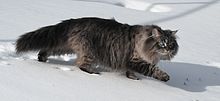Neva Masquarade
As Neva Masquerade (also Neva Masquerade ) refers to the point variant of the Siberian cat . The first long-haired cats of this color were included in the breeding of the Siberian cat in Saint Petersburg . Because of the location of Petersburg on the Neva River and its unusual mask drawing in Russian, the variety received the name Neva Masqueradnaja, and in 1992, in the course of the recognition of the Siberian cat as a breed, the internationally common name Neva Masquerade outside of Russia.
The Neva Masquarade is now recognized worldwide in all umbrella organizations: partly as a sister breed ( FIFe , recognition: January 1, 2011), partly as a color variant of the Siberian cat . The breed standard is identical to that of the Siberian cat.
Emergence
The origin of the point drawing is disputed. The fact is that at the time of the foundation animals such as B. the well-known "Mars", pedigree cats with mask drawings such as Ragdoll , Holy Burma and also real Siamese cats or even Balinese (with verifiable family tree) were not yet available in Russia. The point drawing in itself is rare in street cats in different parts of Russia, but it can be found again and again. Therefore, the mask drawing should have appeared in long-haired specimens well before the start of regular breeding. Real Siamese cats are hardly considered to be the cause of the point mutation, as Siamese cats were very rare in Europe at the beginning of the 20th century and after the Russian Revolution in 1917 the Soviet Union was excluded from the development of pedigree cat breeding. Cats with point coloring are documented next to the Saint Petersburg area, especially on the Volga, where the German naturalist PS Pallas observed a masked cat and made a drawing as early as 1793 . But masked cats are also documented in the area south-east of the Urals before the fall of the iron curtain in the 1980s .
Color variations
The ears, tip of the tail, legs and face are colored dark according to the basic color, while the body is clearly lightened. Like all point cats , the Neva Masquarade is born very bright and darkens with advancing age, especially in cats that spend a lot of time outdoors, even in the cold season. Even with the Neva Masquarade, however, a good contrast between light body color and darker points is desirable. The eyes are always blue, the darker the better. The fur is long and dense in winter with a lush undercoat, in summer it is significantly shorter and simpler.
All basic colors permitted for the Siberian cat are allowed in connection with point. The coloring may be both agouti (wild-colored, tabby ) and nonagouti (monochrome). Nonagouti animals can have ghost drawings. In 2002, starting from a cattery in Germany, the crossing of Somali and later also Holy Burma into the Siberian cat / Neva Masquarade was started in order to establish new color variants -Cinnamon and Fawn- as well as Chocolate and Lilac for the Siberian cats / Neva Masquarade . Crossbreeding of foreign races is not permitted in the forest cat races. These mixed breeds are therefore not recognized as Siberian cats or Neva Masquarade in the vast majority of breed clubs. From a health point of view, this crossing of Somalis is extremely questionable, since with the Somali, which is disposition differently, hereditary diseases that have not previously occurred in the Siberian cat can be carried into this robust breed.
The Siberian cat is the only forest cat breed for which animals with a point factor are recognized.
Appearance, breed standard, characteristics
With the exception of the mask drawing, the Neva Masquarade should not differ from the Siberian cat. The texture of the coat is generally a little softer than that of the full-colored Siberian cats due to the marrow-free hair.
breed
Depending on the umbrella organization, club regulations and personal preferences of the breeder, the Neva Masquarade is bred independently, i.e. H. only Neva Masquarade is paired with Neva Masquarade or mixed-colored Neva Masquarade litters are made with full-colored Siberian cats. The kittens are then entered in the stud books as Neva Masquarade or Siberian cats, depending on their color. Point kittens can also lie in the litter when full-colored parents are mated and carry the point mutation concealed. The point mutation can be passed on undetected for many generations. Even breeders who only breed with full-colored Siberian cats can occasionally have a Neva Masquarade in their litter. Today there is a genetic test for the point mutation, so that breeders can either avoid such surprises or look specifically for a point carrier.
The inclusion of the entire color spectrum in a breeding concept counteracts the narrowing of the Neva Masquarade's gene pool and contributes to maintaining the breed's hereditary health and fitness.




